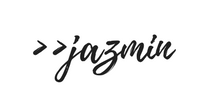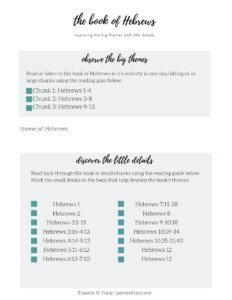Easter and Advent are special times of the year for me. They are two seasons when our hearts want to be in that place of being more focused on Jesus. That’s why I love providing Bible studies and devotional material around this time.
I like helping people make space to meet with Jesus, to love Him and love His story.
This year for Easter, my Devoted Community is going to be studying the book of Hebrews.
Hebrews is one of those books that you’ll find a lot of familiar verses in. It is a wealth of easy-to-memorize and pretty encouraging verses. But there is much more to this book than a handful of memory verses.
Hebrews is a book of promise.
It’s a letter, written to a group of people ready to give up on their faith. Throughout this brief, yet dense book, the author provides encouragement to keep going. To keep believing. To keep choosing faith.
It’s also a book about Jesus, who he is and how great he is.
In the past, Hebrews has been one of those really hard to understand books of the Bible for me. I’d read it, usually chapters at a time, and walk away with one or two verses that stuck out and meant something. But the rest of the book left me scratching my head. It didn’t make sense.
But the more I’ve dug into this rich book the more I’ve been able to see the big picture and all the little details that help develop the major themes of Hebrews.
And those big and little things are exactly what we’ll be studying.
A new-ish Bible study method
For this study, I’ve developed a method (that probably already exists under a different name somewhere) that I’m calling the Big-Little method.
The idea of the Big-Little study method is to grasp the big themes or purpose behind a book of the Bible and then notice all the details that help develop that theme or accomplish that purpose.
I taught middle school English for a couple of years and this was a skill we worked on a lot in understanding both fiction and nonfiction pieces. And as I’ve started teaching the Bible, I’m finding a lot of those literary skills are super useful and necessary when it comes to understanding the Bible.
The Bible is God’s story, it’s his word. But it’s also history and poetry and prophecy and literature.
So I’m giving you this super easy method to help you study any book of the Bible–expect maybe psalms…that’s a whole other beast.
Read Big
When we read big, we read the book in it’s entirety. This can get a little overwhelming for some of your longer books of the Bible like Genesis or Job, but it’s incredibly beneficial.
Preferably when you read big, it’s good to read larger chunks of the book or to read it all in one sitting if you can. This is especially helpful for the books that are written as letters, which make up a good majority of the New Testament.
When you’re focused on seeing how a book of the Bible works as a whole book, rather than taking it chapter by chapter, you’re better able to understand the smaller parts.
For example, I recently worked through the entire book of Job in about five days. I got really ambitious and decided I wanted to a do a read-the-bible-in-90-days reading plan. Spoiler alert: I only made it through day five. But the reading I did do, reading about 14 chapters a day, was super helpful.
Job is one of those books we tend to avoid. This is partly due to it’s content–who really likes to read about suffering? And partly because it’s a book of continuous poetic dialogue full of things that sound like they could be true, but are only kind of half true as Job’s friends speak words that are a far cry from comfort.
As I worked through Job 14 chapters at a time, rather than taking 42 days to read it, I saw the bigger picture. Not all the little details made sense, but I could see a few things I hadn’t noticed before when I read smaller chunks. I saw that God is present. He is there the whole time, present in Job’s suffering. I saw that really neither Job nor his friends have completely right views of God, but God comes in at the end and sets everyone right, humbling Job and correcting his friends’ faulty theology.
Having a big picture view of Job made the book a little less overwhelming.
And that’s exactly what I hope this study on Hebrews does–that it will help you take a dense and sometimes confusing book and give you a big picture view of majors truth the author is trying to convey.

Read Little
The second part of this Big-Little method is, well, the Little part.
After reading through the entire book in one sitting or a few longer sittings, the next step is to go back through and read in smaller chunks. These smaller chunks can be by chapter or by line of thought.
Chapter breaks were not something the original authors included. They were added in much later as a convenient way to reference passages and to study in community. What I found when preparing the material for our Hebrews study, however, is that the chapter breaks are not always in the best place. Sometimes a line of thought continues several verses into the next chapter.
Reading little pays attention to those things. The chapter breaks don’t matter, but the progression of thought does.
In addition to reading smaller chunks, the little part of this method is focused on looking at the details in light of the major themes or purpose of the book.
Back to our Job example, if one of the themes I pulled out was that God is present in suffering, as I read back through the book at a slower pace, I’m going to underline or mark verses and passages that develop that truth.
Next week, we’ll talk more about how and what to mark in your Bible, but for now, it’s important when you’re using this method to get comfortable with the idea of writing in your Bible–or at least keeping a journal nearby for notes and insights.
And that’s really all the Big-Little study method is: Read big for overarching themes and purposes of the book, then go back and read a second time at a slower pace and notice the small details that support and develop the themes.
Want to try out this study method for yourself?
I’ve created a study guide for the book of Hebrews that you can download from my resource library.
The first week of the study you’ll focus on reading big and move through the entire book of Hebrews. The last two weeks, you’ll slow down and move through the book a second time at a slower pace, noticing how the author develops one big theme as well as a handful of smaller ones.
Community Question: What Bible study methods do you like to use?
Related: 5 Great Resources for Daily Bible Study
Live in his love




Interesting, Jazmin! I offer Bible studies through Facebook too and we did Hebrews last year. It was such a powerful book that deeply impacted me. I take more of the “little” approach–showing people how to mine the gems that often get overlooked when we read in bigger gulps. But I like what you’ve said about how it brings into focus some of the concepts we might miss by getting up too close. Thanks for sharing and I’ve pinned to my Bible Studies board! God bless you in your efforts to strengthen other’s spiritually!